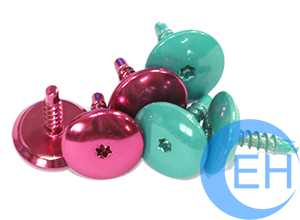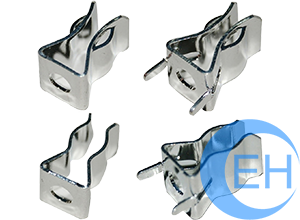| Electroplating styles |
| Picture |
Name |
Description |
 |
Anodizing |
Electroplating anodizing films are most commonly applied to protect aluminum alloys, although processes also exist for titanium, zinc, magnesium, niobium, zirconium, hafnium, and tantalum. Iron or carbon steel metal exfoliates when oxidized under neutral or alkaline micro electrolytic conditions; i.e., the iron oxide (actually ferric hydroxide or hydrated iron oxide, also known as rust) forms by anoxic anodic pits and large cathodic surface, these pits concentrate anions such as sulfate and chloride accelerating the underlying metal to corrosion. Carbon flakes or nodules in iron or steel with high carbon content (high-carbon steel, cast iron) may cause an electrolytic potential and interfere with coating or plating. Ferrous metals are commonly anodized electrolytically in nitric acid or by treatment with red fuming nitric acid to form hard black ferric oxide. This oxide remains conformal even when plated on the wire and the wire is bent. |
 |
Chrome plating |
Electroplating chrome plating is a finishing treatment using the electrolytic deposition of chromium. The most common form of chrome plating is the thin, decorative bright chrome, which is typically a 10-µm layer over an underlying nickel plate. When plating on iron or steel, an underlying plating of copper allows the nickel to adhere. The pores (tiny holes) in the nickel and chromium layers work to alleviate stress caused by thermal expansion mismatch but also hurt the corrosion resistance of the coating. Corrosion resistance relies on what is called the passivation layer, which is determined by the chemical composition and processing and is damaged by cracks and pores. In a special case, micropores can help distribute the electrochemical potential that accelerates galvanic corrosion between the layers of nickel and chromium. Depending on the application, coatings of different thicknesses will require different balances of the aforementioned properties. Thin, bright chrome imparts a mirror-like finish to items such as metal furniture frames and automotive trim. Thicker deposits, up to 1000 µm, are called hard chrome and are used in industrial equipment to reduce friction and wear. |
 |
Dacromet plating |
Dacromet is the leading inorganic coating specified by automotive companies worldwide and is a proven coating system in many industries. A water-based, VOC compliant coating, dacromet is comprised mainly of overlapping zinc and aluminum flake in an inorganic binder.
Four-Way Corrosion Protection
Barrier Protection: Overlapping zinc and aluminum flakes provide an excellent barrier between the steel substrate and the corrosive media
Galvanic Action: Zinc corrodes to protect steel
Passivation: Metal oxides slow down the corrosion reaction of zinc and steel to provide 3 times greater corrosion protection than pure zinc
Self-Repairing: Zinc oxides and carbonates migrate to the damaged area of the coating to actively repair the coating and restore barrier protection |
 |
Electrophoresis |
Electroplating electrophoresis is the motion of dispersed particles relative to a fluid under the influence of a spatially uniform electric field. This electrokinetic phenomenon was observed for the first time in 1807 by Ferdinand Frederic Reuss (Moscow State University), who noticed that the application of a constant electric field caused clay particles dispersed in water to migrate. It is ultimately caused by the presence of a charged interface between the particle surface and the surrounding fluid. It is the basis for a number of analytical techniques used in chemistry for separating molecules by size, charge, or binding affinity. |
 |
Zinc plating |
Electroplating zinc platings prevent oxidation of the protected metal by forming a barrier and by acting as a sacrificial anode if this barrier is damaged. Zinc oxide is a fine white dust that (in contrast to iron oxide) does not cause a breakdown of the substrate’s surface integrity as it is formed. Indeed, the zinc oxide, if undisturbed, can act as a barrier to further oxidation, in a way similar to the protection afforded to aluminum and stainless steels by their oxide layers. The majority of hardware parts are zinc-plated, rather than cadmium-plated. |
 |
Gold plating |
Electroplating gold plating is a method of depositing a thin layer of gold on the surface of glass or metal, most often copper or silver.
Gold plating is often used in electronics, to provide a corrosion-resistant electrically conductive layer on copper, typically in electrical connectors and printed circuit boards. With direct gold-on-copper plating, the copper atoms have the tendency to diffuse through the gold layer, causing tarnishing of its surface and formation of an oxide/sulfide layer. Therefore, a layer of a suitable barrier metal, usual nickel, has to be deposited on the copper substrate, forming a copper-nickel-gold sandwich. |
 |
Nickel plating |
Electroplating nickel plating is a technique of electroplating a thin layer of nickel onto a metal object. The nickel layer can be decorative, provide corrosion resistance, wear resistance, or used to build up worn or undersized parts for salvage purposes.
Nickel electroplating is a process of depositing nickel on a metal part. Parts to be plated must be clean and free of dirt, corrosion, and defects before plating can begin. To clean and protect the part during the plating process a combination of heat treating, cleaning, masking, pickling, and etching may be used. Once the piece has been prepared it is immersed into an electrolyte solution and is used as the cathode. The nickel anode is dissolved into the electrolyte in the form of nickel ions. The ions travel through the solution and deposit on the cathode. |
 |
Silver plating |
For applications in electronics, electroplating silver is sometimes used for plating copper, as its electrical resistance is lower (see Resistivity of various materials); more so at higher frequencies due to the skin effect. Variable capacitors are considered of the highest quality when they have silver-plated plates. Similarly, silver-plated, or even solid silver cables, are prized in audiophile applications; however, some experts consider that in practice the plating is often poorly implemented, making the result inferior to similarly priced copper cables. |
 |
Tin plating |
The electroplating tin-plating process is used extensively to protect both ferrous and nonferrous surfaces. Tin is a useful metal for the food processing industry since it is non-toxic, ductile, and corrosion-resistant. The excellent ductility of tin allows a tin coated base metal sheet to be formed into a variety of shapes without damage to the surface tin layer. It provides sacrificial protection for copper, nickel and other non-ferrous metals, but not for steel. |
 |
Zinc nickel plating |
Electroplating zinc-Nickel plating is one of the best corrosion-resistant finishes available offering over 5 times the protection of conventional zinc plating and up to 1,500 hours of Neutral Salt Spray test performance. This plating is a combination of a High Nickel Zinc-Nickel alloy (10% – 15% nickel) and some variation of chromate. The most common mixed chromates include Hexavalent Iridescent, Trivalent or Black Trivalent Chromate. Used to protect steel, cast iron, brass, copper, and other materials, this acidic plating is an environmentally safe option. Hexavalent Chromate has been classified as a human carcinogen by the EPA and OSHA. |










